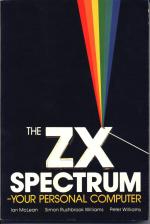
ZX Computing
 1st October 1983
1st October 1983
Categories: Review: Book
Author: Patrick Cain
Publisher: Prentice-Hall International
Machine: Spectrum 48K
Published in ZX Computing #9
The ZX Spectrum: Your Personal Computer
The ZX Spectrum: Your Personal Computer is a departure from the 'norm' of computer books, and one which fills an area so often ignored, that of the newcomer to computing. The authors, Ian McLean, Simon Rushbrook Williams and Peter Williams, all members of the Micro Electronics Educational Development Centre, Paisley College, Scotland, have identified the difficulties that often beset the first time user. Personal computing is not the preserve of 'a special elite of geniuses' as many other books appear to assume and if you've all but gone blue in the face PEEKing and POKEing and getting nowhere then this may be the book you need.
From pages one to 216, the text is lighthearted and entertaining. In eleven chapters, it covers what the computer can do, how to use the keyboard, loading and saving programs through to files and data handling, and if you're unsure how the pieces which comprise a full unit are assembled or how to wire the plug, it covers that too. Any learning process is always easier if it's enjoyable and while the scope of the book is not far reaching, it is neither elementary - rather it assumes no previous knowledge and moves from this most elementary stage to clearly cover all that is necessary to write well-written programs in a most enjoyable fashion.
Before the software came the hardware and before any worthwhile software is written, it is essential to have a good working knowledge of the bits and pieces. Chapters one to three look at how to get the apparatus up and working properly; saving to and loading from tape, verifying at each stage that what you wanted to do has been done; exploring the keyboard and what each button does - each step is discussed in a clear but uncomplicated way and accompanied by diagrams. At no point are you likely to get the feeling that tells you the next move is the one which will ruin your new investment.
With new-found confidence, tackle chapter five, and see what the Sinclair ROM (by this time you'll know exactly what that is!) has provided to enhance the programs you'll soon be writing. The graphic attributes BORDER, PAPER, INK, etc, are all put through their paces. The PRINT statement is introduced and tested. But where the going gets heavy, schematic diagrams and flow charts accompany the text to illustrate what is being discussed. Again, as in the previous chapters, each point is detailed with examples to test the theory.
Computer programs are a series of logical steps, but the trouble is that people tend not to be too logical. Chapter six, 'Making Decisions', deals with the language of the Spectrum. The Basic commands are introduced (again the approach is a 'suck it and see' style) the sense of each command, being borne out by the examples which are given. Building from what has gone before, the scope of each command is investigated, reinforcing and confirming the earlier theory, cross-referencing the manual and explaining clearly what the manual often assumes. Here, as throughout, the various sections open with a listing and definition of each of the language elements to be discussed and concludes with a summary of what has been covered.
In chapter seven, 'Words and Numbers', a study of data manipulation statements, LEN, VAL, STR$, ABS, etc, discusses the finer points of Spectrum Basic. Commands which might otherwise have gone unused through a lack of understanding, but ones that are nonetheless inherent in any accomplished program, are clarified with reasons for their use and helpful examples.
With equal commitment to ease of understanding and clarity, the remaining chapters examine the sound and graphics capabilities on the Spectrum. Worthy of special note is chapter ten, 'Files and Data Handling'. This is perhaps a difficult area to grasp for anyone not familiar with the sizeable amounts of data, but again the treatment is such that the complexities of the problem are greatly diminished.
Throughout, the standard of The ZX Spectrum: Your Personal Computer is high. A good foundation is an essential part of any advanced programming endeavour. On completion of this book it is likely that you will move with ease to higher level books; certainly your command of Basic should enable you to write good quality programs encompassing all of the features of Spectrum Basic.
Other Reviews Of The ZX Spectrum: Your Personal Computer For The Spectrum 48K
The ZX Spectrum - Your Personal Computer
A review by JL (Personal Computer News)
Scores
Spectrum 48K Version| Overall | 80% |


